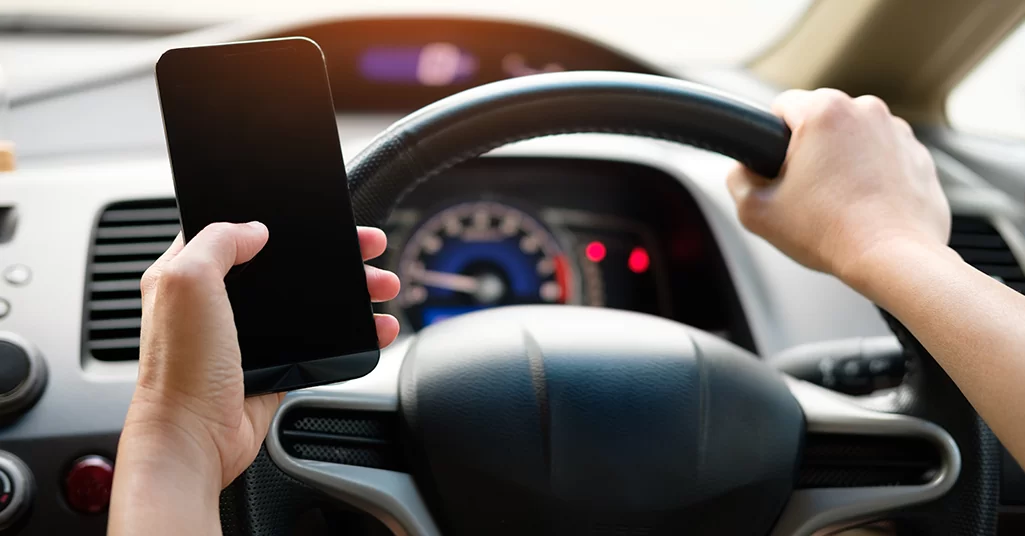Distracted driving is a significant problem, especially for occupational drivers. It affects not just the safety of the driver but everyone on the road. This blog will explore distracted driving, its causes, common distractions and prevention strategies. The goal is to help occupational drivers stay focused and safe.
What is Distracted Driving?
Distracted driving is when a driver’s attention is diverted away from driving. It involves any activity that takes focus off the road, such as visual, manual or cognitive distractions. When drivers are distracted, their reaction times slow down, leading to accidents and dangerous situations.

What Causes Distracted Driving?
Distractions come in many forms. Here are the most common ones that occupational drivers face:
- Mobile Phones: Texting, calling or checking notifications can divert attention from the road and lead to potentially dangerous situations.
- Eating and Drinking: Grabbing a bite or a sip seems harmless but can take a driver’s hands off the wheel and eyes off the road.
- Navigation Systems: Entering addresses or adjusting settings on GPS devices requires focus, which can easily cause drivers to lose track of their surroundings.
- Radio and Music Players: Changing stations, adjusting volume or selecting playlists can be distracting, as they divert attention from driving.
- Passengers: Conversations or interactions with passengers can distract the driver from driving tasks, increasing the risk of an accident.
- Scenery and Billboards: Eye-catching advertisements or beautiful scenery can momentarily draw a driver’s gaze away from the road, creating a distraction.
- Daydreaming: Long drives can lead to a driver’s mind wandering, causing them to lose focus on driving.
- Adjusting Controls: Tweaking the air conditioning, seat position or mirrors while driving requires attention and can distract the driver from the road.
The Law
In the UK, it is illegal to hold and use a phone, tablet or any device capable of sending or receiving data while driving, whether online or offline. This prohibition includes activities such as texting, calling, taking photos, using satellite navigation or browsing the web, and applies even when stopped at traffic lights, queuing in traffic or supervising a learner driver.
Exceptions are made only for certain situations, including emergency calls to 999 or using a device while safely parked.
Hands-free use is allowed if the device is not held and does not obstruct the driver’s view. Drivers must remain in complete control of their vehicle at all times; failure to do so can result in being stopped by the police, penalty points, fines and potentially losing their licence if they are new drivers. Serious offences may lead to court appearances, driving bans and fines up to £1,000 (£2,500 for lorry or bus drivers).
Distracted Driving Prevention Strategies
- Put the Phone Away
One of the best strategies is to put the phone away. Turn it off or use a “Do Not Disturb” mode while driving. Some apps can block calls and texts while driving, keeping you focused on the road.
- Plan Ahead
Planning the route before starting the trip is essential. Set the GPS and adjust radio or air conditioning controls before driving. This reduces the need to fiddle with devices while on the road, keeping your attention where it belongs.
- Use Hands-Free Devices
If a phone call is necessary, use a hands-free device. However, it’s best to keep calls short and avoid them if possible. Even hands-free calls can be distracting, so it’s better to focus entirely on driving.
- Take Breaks
Long drives can lead to fatigue and distractions. Take regular breaks to rest and recharge. This helps maintain focus and alertness, reducing the risk of accidents caused by drowsiness or inattention.
- Avoid Eating and Drinking
Refrain from consuming food while driving, as these actions divert your hands and eyes from operating the vehicle safely. If necessary, find a safe place to stop and take a break. This way, you can enjoy your meal without compromising safety.
- Educate and Train
All occupational drivers should receive adequate training to improve road awareness and ensure the safe operation of their vehicles. Driver safety awareness course makes drivers safer and more focused by teaching them how to drive within speed limits, minimise distractions and maintain concentration.
- Set Rules for Passengers
Set clear rules for passengers to minimise distractions. This includes keeping conversations light and ensuring pets are secured. By managing the behaviour of those in the car, drivers can maintain better focus on driving.
- Stay Calm and Focused
Stress and emotions can distract drivers. Adopt stress management techniques like deep breathing or calming music to maintain focus on the road. Staying calm and focused on the road helps drivers make better driving decisions and reduces the risk of accidents.

Benefits of These Driving Prevention Strategies
Implementing these strategies offers numerous benefits, including:
- Safety: Decreases the chances of accidents and injuries, ensuring that drivers and other road users remain unharmed.
- Cost Savings: Fewer accidents mean lower repair costs and insurance premiums, saving money for both drivers and employers.
- Improved Efficiency: Staying focused ensures timely deliveries and better service, enhancing productivity and customer satisfaction.
- Peace of Mind: Drivers and employers feel more secure knowing that adequate measures are in place to prevent accidents and distractions.
- Compliance: Adhering to regulations avoids fines and legal issues, keeping the company in good standing with regulatory bodies.
- Reputation: Companies known for safe driving practices build better reputations, attract more business and foster trust with clients and the community.
Conclusion
Distracted driving is a big issue, especially for occupational drivers. Understanding its causes and common distractions is the first step in prevention. Adhering to regulations and implementing effective strategies can save lives and resources. These prevention strategies help enhance driver safety and make the streets safer for everyone.






